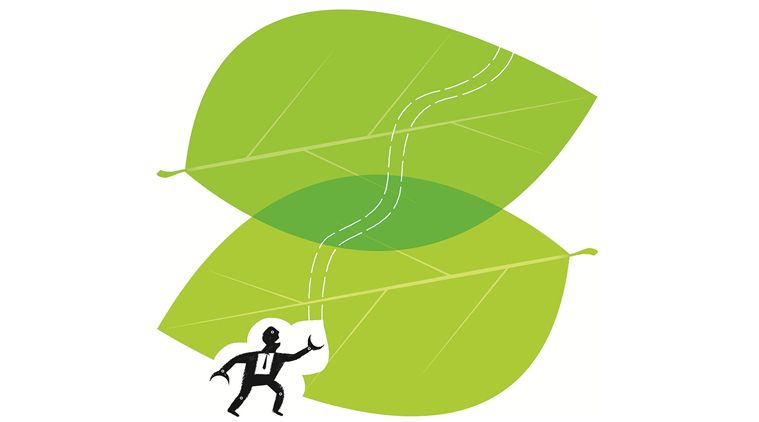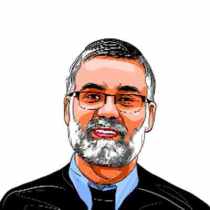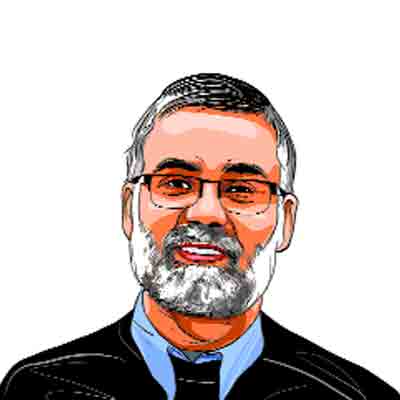A gated revolution
Current forms of urban politics construct a new aam aadmi: The relatively privileged white-collar professional who feels he has been denied his rights due to ‘appeasement’ of the poor.

The current forms of urban politics are quite different from mass political movements we have seen in the past and it is this difference that holds the key to kind of society we may end up with. Its key concerns are based on redefining the idea of the ‘ordinary’ person. (Illustration: CR Sasikumar)
Urban India is the site of the most dramatic changes in human life. The manner in which we work, live, play, do business, enter into relationships and construct communities is firmly entrenched in the life of our cities. The romanticised village of post-Independence cinema holds little interest for young people in particular, as they seek new futures within possibilities offered by the inexorable expansion of urban agglomerations. Through unplanned and semi-planned means, our cities absorb — with different degrees of hospitality — migrants of different capacities, including those escaping provincial feudal social and economic structures and the fading promise of regional development. In 2011, for the first time since the Census came into being, the absolute urban growth recorded a higher rate than the rural one. Urban life for many may still be brutish, but it is possibly longer and not as short as in the countryside.
The exuberant abandon of urban growth has been accompanied by a quieter but just as significant process that will also deeply influence city life in subsequent years: A very significant middle-class participation in urban planning and development. This new aspect of the urban can be most frequently witnessed in the manner in which Residents Welfare Associations (RWAs) are able to galvanise members to act on an issue that affects their perceived interests. The growth of RWAs is, in turn, linked to both political nurturing of an important constituency (such as the Delhi Bhagidari scheme under the Congress) and a gathering sense of self among middle-class urban residents.
This is a new form of activism, enacted through lycra-clad bicycle enthusiasts, leisure activists, environmentalists, bird-watchers and “ordinary mums and dads” who want a better life in the city. The ongoing residents’ campaign against the construction of a six-lane highway through Gurgaon’s Aravalli Bio-Diversity Park that stretches over 400 acres is a case in point. Spurred through word of mouth, social media and news reports, protesters have gathered in their thousands, with steely resolve and placards aloft. Alongside, local editions of national newspapers have carried extended coverage of protests as well as columns by Gurgaon residents that speak of the kinds of sustainable infrastructure that cities need for a decent life. The protagonists are articulate and rational in their evaluation: The urban fabric requires careful attention to the balance between physical and natural surroundings. “Who will bring back the birds?”, they rightly ask in one strong voice.
Strangely, however, cities such as Gurgaon hardly ever elicit such response — and it is difficult to gather a group of 50 protesters — when it is the social fabric of the city that is in question. In the very recent past, the city has been witness to events that are fundamental to defining the social nature of cities. In Gurgaon, for example, one religious community’s public right to worship has been sought to be curtailed (while placing no limits on others) and there have been severe disturbances that relate to working conditions of factory labour, including those at Maruti’s factory in Manesar.
Another site of significant urban development near Delhi, Noida, witnessed a riot-like situation when workers stormed a gated enclave to protest against the alleged overnight detention of one of their colleagues who worked in the complex. These, too, are issues and events that determine the nature of a city.
However, it frequently appears that the more our cities expand, the more narrow — and gated — our perspective of our place within them. It is striking that the well-off primarily consider urban life as the sum-total of its physical infrastructure, gathering in large numbers to protest against it or argue for it. However, the social life of a city — a decent existence for its most vulnerable populations — appears to not interest many. The emerging nature of urban politics, an apparent revolution that primarily concerns itself with the interests of a small group versus wider discontent that parades in tattered saris and trousers has the potential to produce deeply fragmented cities, if it hasn’t already done so.
The current forms of urban politics are quite different from mass political movements we have seen in the past and it is this difference that holds the key to the kind of society we may end up with. Its key concerns are based on redefining the idea of the “ordinary” person. The ordinary person now is the relatively privileged white-collar professional who, it is asserted, has been exploited and denied his or her rights because of state “appeasement” of the poor. The ordinary person pays taxes and gets little in return; the ordinary person pays for electricity while slum-dwellers steal it. The anger of this ordinary man is at the heart of a new sense of the city where the apparently dispossessed stake a claim through agitational activities that are increasingly narrowly defined in terms of their objectives. This new outlook seems particularly prevalent in newer urban locations where the separation between the well-off and the poor is embedded in the fundamentals of planning.
Our cities will fail not just because we lack parks, gardens and highways. Rather, they will slide into dystopian states because of a failure of the imagination. The nature of a liveable city is fundamentally connected to the possibilities of freedom and decency of life for the vast majority that has limited means to influence these aspects. A “global” or “smart” city is, primarily, an advanced form of habitation because of the manner in which its residents think. What is required is an urban consciousness that is concerned with both the physical infrastructure as well as its social one: Diversity, equity, and fair treatment of its most vulnerable workers. Without such a consciousness, we will end up with a situation where it is easy to gather the well-off to defend a park but impossible to make them rise to defend the idea of a city.
The writer is professor of sociology at the Institute of Economic Growth, Delhi
For all the latest Opinion News, download Indian Express App
More From Sanjay Srivastava
- How to Repair a Broken SystemUniversities must diversify and innovate to serve the needs of the majority..
- For A Culture Of CriticismRe-thinking the relationship between privileged universities and the rest is essential ..
- The content of charismaJayalalithaa’s appeal lay in her ability to help her followers straddle multiple worlds...







































No hay comentarios:
Publicar un comentario